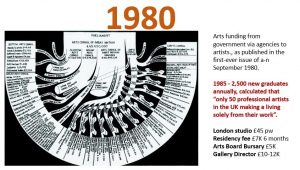
‘Artists always get lost…’
Delivering ‘human thriving’ in and through the arts, including fair pay for artists, in a pandemic world calls for substantial shifts in how arts policies are made and where they are realised.
Read “Leave no stone unturned, for artists’ sake” in full

Arts Professional article introduction
Government and Arts Council England were praised in the Covid19 emergency for fast implementation of ad hoc strategies for financial support for arts and cultural institutions and job retention schemes for salaried staff. Despite the equality and diversity rhetorics of the funded arts, analysis of responses to the DCMS Inquiry into the Impact of Covid-19 reveal that individual freelance visual artists will suffer worst unless additional remedial actions are taken.
Read “Artists’ livelihoods in freefall” in full

Case 4 Culture data
Data set from Case 4 Culture freelance survey
“We cannot be content to go back to what was before, as if all is normal… there needs to be a resurrection of our common life.” Justin Welby, Archbishop of Canterbury.
The Easter sermon – opined from the Archbishop’s kitchen and disseminated via social media to some 18,000 people – provided the cue for a discussion on how to ensure artists’ survival in an arts and cultural environment poleaxed by Covid-19.
Read “Treating the rash or investing in a cure: the future of artists’ livelihoods” in full
This Research paper commissioned by a‑n The Artists Information Company is part of a series which first began in 2007 as a means of providing on-going evidence and insight on the context for, and nature of, employment for visual artists. By referencing data from prior years, Artists work in 2016 identifies the implications of changes in the conditions for artists’ employment and livelihoods and proposes some areas for consideration by those charged with formulating policy and measuring the economic and social impact of the arts.
Read “Artists work in 2016” in full
This resource that includes commentary, evidence and advice is intended for individual artists, arts organisers, commissioners, trainers and policymakers intended to achieve equitable and inclusive conditions in which individuals can flourish. It’s a basis for exploring frictions and misassumptions about artists and pay and understanding why individual negotiation is a vital to ensuring productive exchanges and collaborations.
Read “Artists and pay - 20+ inspiration and information sources” in full
This audio of a presentation by Susan Jones at Work and Art, CRATE, UCA Canterbury, March 2015, considers the climate for visual artists’ practice and their ability to make a living. Referencing evidence and data from arts and cultural sources over the last thirty years and considering insight from future forecasting, it identifies the prevailing issues surrounding support to artists and their livelihoods within the public sector. It concludes by articulating some of the inherent issues and challenges within the current and future ecology for artists and the contemporary visual arts to be addressed by public funders and the sector alike.
Read “Ways and means: livelihood strategies 1984 to 2014” in full





